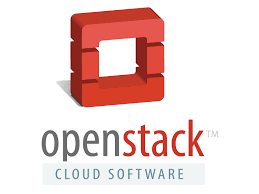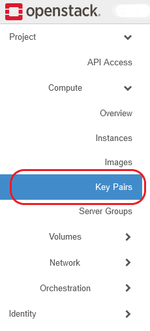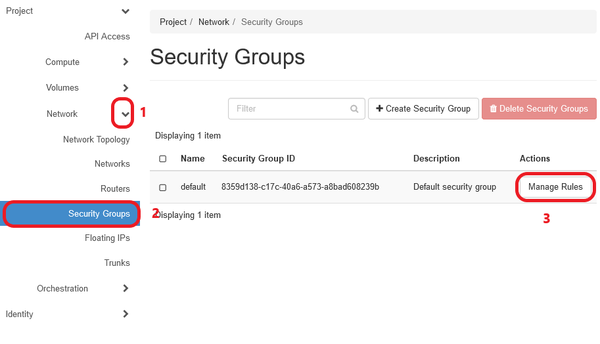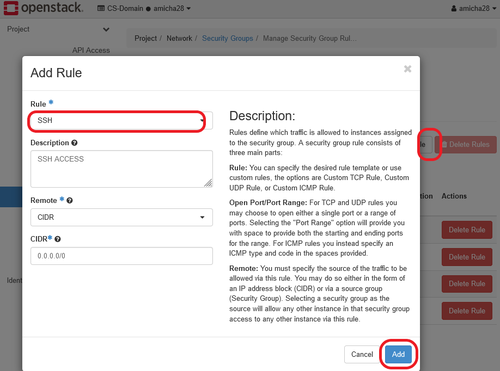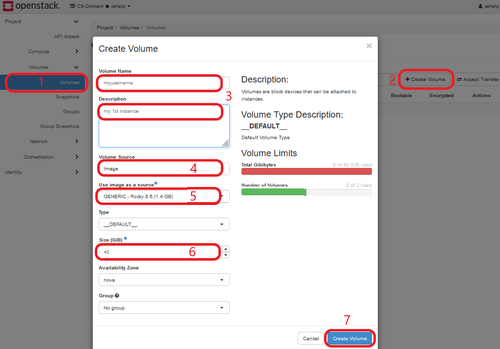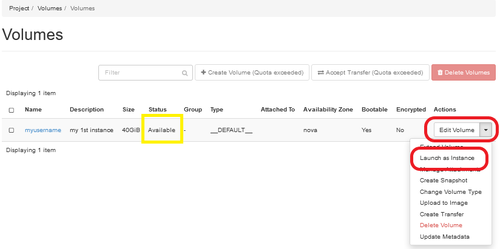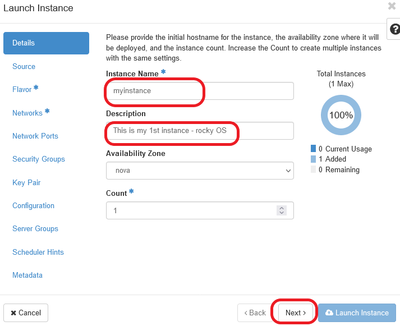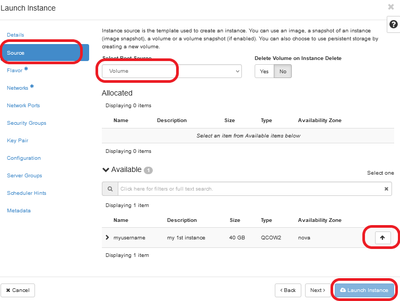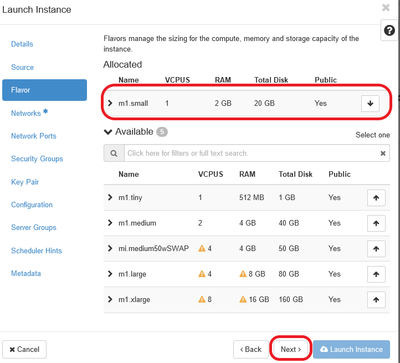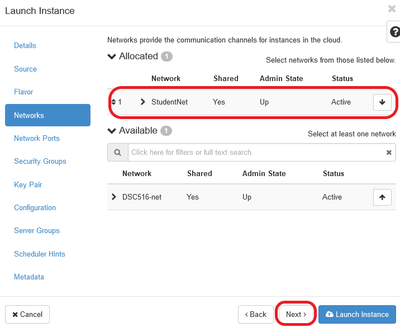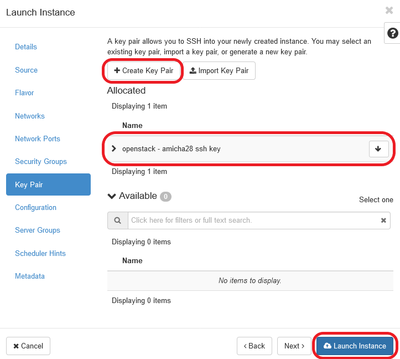Difference between revisions of "Cloud"
| Line 48: | Line 48: | ||
[[File:Openstack_instance7.png|thumb|left|600px|Security Group]] | [[File:Openstack_instance7.png|thumb|left|600px|Security Group]] | ||
[[File:Openstack_instance8.png|thumb|center|500px|Add rule]] | [[File:Openstack_instance8.png|thumb|center|500px|Add rule]] | ||
| − | + | ||
===Images=== | ===Images=== | ||
| Line 58: | Line 58: | ||
==Launching your first instance== | ==Launching your first instance== | ||
| − | |||
| − | |||
| − | |||
| − | |||
| − | |||
| − | |||
| − | |||
| − | |||
| − | |||
| − | |||
| − | |||
| − | |||
| − | |||
| − | |||
| + | Once your keypair is created or uploaded head over to the Volumes page to launch your first instance. <br> | ||
| + | ===Create a volume with image applied=== | ||
| + | [[File:Openstack_instance0.png|thumb|center|500px|START]] | ||
| + | Create a new volume under Volumes menu, pick image as image source and make your selection from the dropdown list of preconfigured images (5). Size is recommended to be 40GB (6) as we are using the full quota given. Choose Create Volume. | ||
| + | Wait until the volume is ready and available to proceed to the next step. Make a cup of coffee :-) | ||
| + | [[File:Openstack_instance_volume.png|thumb|center|500px|PREPARE VOLUME]] | ||
| + | When volume is ready and available (may take some minutes) from drop down Choose Launch Instance and proceed to the next steps. | ||
| + | <br><br><br><br><br> | ||
| + | ===Launch your instance=== | ||
| + | Here's a quick rundown of what to choose: | ||
Revision as of 07:10, 9 November 2022
Cloud: Overview
Introduction
The oStack is a new facility that provides self-service virtual machines and storage directly to end users within the Department. Virtual machines can be provisioned in seconds, can be easily rebuilt, and have direct console access when required. This is managed easily through a web interface and doesn't require any direct interaction with us.
The system is based on OpenStack. If you've used other cloud-based systems from Amazon, Google, Rackspace, or many others, then this should be familiar to you.
Access
Access is limited and at least in the short term will only be available to senior students of the Department and faculty.
Getting started
Once you have access you will notified via email with the OpenStack interface link to the login page.
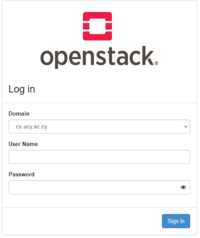
Log in to the Dashboard
The Login URL to access the dashboard follows:
http://ostack.in.cs.ucy.ac.cy/
You should fill the fields specifying the Domain of your Project, username, and password (Fig. 1).
The default domain (drop down) for most use cases will be simply “cs.ucy.ac.cy”, and username and password will be your University credentials without the @ucy.ac.cy for authentication.
Here are some things to take note of before you get started:
SSH keys
To log in to virtual machine instances you will need an SSH key pair; passwords are not used (although you're free to set one once you've logged in to the instance for the first time). An SSH key pair consists of two parts - the private part which you retain and keep secure, and the public part which you can provide to other systems such as this one. When logging in to a system the server confirms that you have the matching private key for the public key it has before letting you log in. For convenience you may want to generate the key pair on a system that you can easily access and that can directly access your cloud instances.
You have an option to use and import public key you already have and use generated via your operating system or generate one via Openstack dashboard. If you choose to generate one via Openstack Click “Key Pair”, then click + Create Key Pair from the interface (Fig.2). Your private key will be downloaded from interface as <name>.pem file.
STORE SAFELY and do not loose it, otherwise you are loosing the access to your instances using this key.
On a Linux system, an Apple Mac, or other Unix-like systems such as FreeBSD, you can easily make a key pair by using the ssh-keygen command. The public key, by default, should be in ~/.ssh/id_rsa.pub on the machine you ran ssh-keygen on. The private part is also in ~/.ssh and will be found automatically by the ssh client when needed.
On Windows systems you can use PuTTYgen from the PuTTY package. This performs the same task as ssh-keygen and creates a key pair. The public key part is what you need to provide to OpenStack. However, as above, you may find it easier to use PuTTY to log in to any Linux machine and then generate the key there instead.
Security Group
A security group is a named collection of network access rules (like a firewall) that are use to limit the types of traffic that have access to instances. When you launch an instance, you can assign one or more security groups to it. To start your first instance, if you need to access your instance via ssh you follow the procedure below. Using the same procedure you open port 80 (HTTP) if you install a webserver or any other ports.
Images
All virtual machine instances are launched from images. We've provided a number of cloud images for popular operating systems already. For all the current images the initial username is the lower-cased name of the operating system. For example, for the Ubuntu images the username is ubuntu, for Rocky images the username is rocky etc.
You can also upload your own images. Where possible these should be in RAW format. If they're likely to be of interest to others it might be worth asking us to provide it for everyone instead.
Please note that we are not licensed to run Windows.
Launching your first instance
Once your keypair is created or uploaded head over to the Volumes page to launch your first instance.
Create a volume with image applied
Create a new volume under Volumes menu, pick image as image source and make your selection from the dropdown list of preconfigured images (5). Size is recommended to be 40GB (6) as we are using the full quota given. Choose Create Volume. Wait until the volume is ready and available to proceed to the next step. Make a cup of coffee :-)
When volume is ready and available (may take some minutes) from drop down Choose Launch Instance and proceed to the next steps.
Launch your instance
Here's a quick rundown of what to choose:
STEP1: On the Details page pick a name for your instance. This will also be the internal hostname for the virtual machine.
STEP2: On the Source page select the image that you wish to use. Press the arrow button to the right of the name to select it.
STEP3: The Flavor page gives a choice of different sized instances. Pick a suitable one, probably m1.small for your first instance. Also see the Quota limits section below.
STEP4: Select StudentNet by clicking on the arrow button to the right of the name.
You can ignore Network Ports and leave default Security Group to start with.
STEP5: On Key Pair select the key pair that you created previously. If you omit this step make sure you create a KeyPair now otherwise you will not be able to log in to your instance! THIS IS VERY IMPORTANT.
For now you can also ignore the Configuration and Metadata pages.
Hit the Launch Instance button.
After a few moments the instance will be created and booted. The Instances page will provide you with the status of the instance and its IP address. You can log in use an SSH client and the key you created previously. If the instance does not respond immediately, or you can't log in, please give it a minute or two to finish booting. You can watch the progress through the interface and view the console of the machine via console tab.
You are now ready to log in to new instance using the ip Address appear in the interface and using the username of the image you are using and of course using your ssh key.
Note that to access the instance from off-campus you will need to use the VPN.
Quota limits
Projects on OpenStack (of which each user has their own personal one) have limits on CPU, memory, disk usage and more. Once you've used all of the quota that we've assigned to you, you'll no longer be able to launch any instances. Deleting unused instances will free up the resources for you to use. If you need more quota than we've provided please contact us to discuss your requirements.
Further reading
Most of the OpenStack documentation is directly applicable to our system. The OpenStack End User Guide is a good place to start to get a better understanding of how to use OpenStack.
However, please note that we have only implemented the basic facilities. Therefore the interface is available through http only and some functionalities such as backup are still missing. We aim to provide this when we next upgrade OpenStack.
Questions
If you have an questions or problems please contact us for advice.
